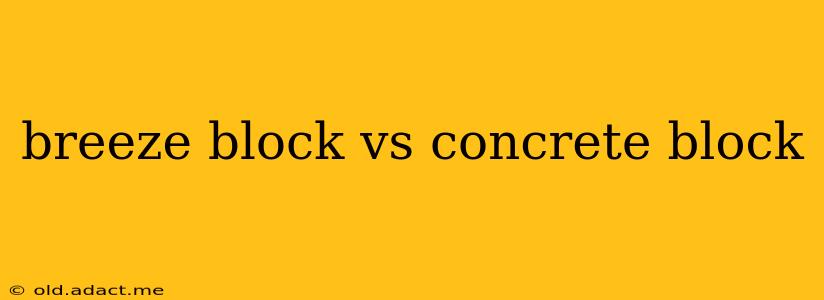Choosing the right building block can significantly impact the aesthetics, functionality, and overall cost of your project. This detailed comparison of breeze blocks and concrete blocks will help you make an informed decision. We'll delve into their key differences, highlighting strengths and weaknesses to guide you towards the optimal choice for your specific needs.
What is a Breeze Block?
Breeze blocks, also known as aircrete blocks or perforated concrete blocks, are lightweight hollow blocks featuring numerous holes or perforations throughout. These holes allow for better air circulation and reduce the overall weight of the block, making them easier to handle and transport. They are typically made from a mix of cement, sand, and aggregates.
What is a Concrete Block?
Concrete blocks, also known as cinder blocks or CMU (Concrete Masonry Units), are solid or hollow blocks made from a mix of cement, aggregates (such as gravel or crushed stone), and water. They are denser and heavier than breeze blocks, offering greater strength and sound insulation. While they can be hollow, the perforations are typically fewer and smaller than those found in breeze blocks.
Breeze Block vs. Concrete Block: Key Differences
Here's a table summarizing the key differences between breeze blocks and concrete blocks:
| Feature | Breeze Block | Concrete Block |
|---|---|---|
| Weight | Lighter | Heavier |
| Strength | Lower | Higher |
| Thermal Properties | Better insulation, cooler interior | Less insulation, can retain heat |
| Sound Insulation | Poorer | Better |
| Cost | Generally less expensive | Generally more expensive |
| Air Circulation | Excellent | Limited |
| Appearance | Often more aesthetically pleasing (depending on design) | More utilitarian appearance |
| Workability | Easier to handle and install | More challenging to handle and install |
What are the advantages of breeze blocks?
- Cost-effective: Breeze blocks are usually cheaper to purchase and transport due to their lighter weight.
- Excellent ventilation: The numerous holes allow for natural airflow, keeping the interior cooler in hot climates. This can translate to lower energy bills from reduced air conditioning use.
- Lightweight and easy to handle: This makes them ideal for DIY projects and simplifies the construction process.
- Aesthetic appeal: Certain designs offer a more modern and visually appealing finish compared to traditional concrete blocks.
What are the disadvantages of breeze blocks?
- Lower strength: They are less structurally sound than concrete blocks and may require additional reinforcement in load-bearing applications.
- Poorer sound insulation: The holes allow sound to pass more easily than in solid concrete blocks.
- Susceptibility to damage: Breeze blocks can be more vulnerable to cracking or damage during handling and installation if not handled carefully.
- Limited load-bearing capacity: Not suitable for applications requiring high structural integrity.
What are the advantages of concrete blocks?
- High strength: Concrete blocks offer superior structural support and load-bearing capacity.
- Good sound insulation: They provide better noise reduction compared to breeze blocks.
- Durability: They are more resistant to damage and weathering than breeze blocks.
- Versatility: They are suitable for a wider range of applications, including load-bearing walls and foundations.
What are the disadvantages of concrete blocks?
- Higher cost: Concrete blocks are typically more expensive than breeze blocks.
- Heavier and more difficult to handle: This can increase labor costs and make installation more challenging.
- Poorer thermal insulation: They can retain heat, making the interior warmer in hot climates.
- Less aesthetic appeal: Their appearance is often considered less visually appealing than some breeze block designs.
Which block is right for me?
The best choice depends on your specific project needs and priorities.
- For projects prioritizing cost and ventilation (e.g., garden walls, non-load-bearing partitions): Breeze blocks are the likely better option.
- For projects requiring high strength and sound insulation (e.g., load-bearing walls, foundations): Concrete blocks are the preferred choice.
Consider factors like budget, structural requirements, climate, and aesthetic preferences before making a final decision. Consulting with a building professional can offer further guidance tailored to your specific project.
